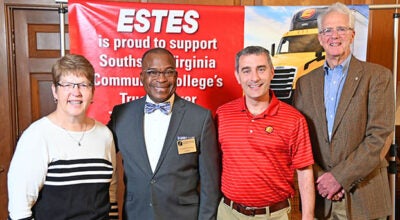Ragsdale was among first Blacks to serve as a delegate
Published 8:31 pm Friday, February 5, 2021
|
Getting your Trinity Audio player ready...
|
On July 6, 1869, William H. Ragsdale, a former slave, made history when he was elected to represent Charlotte County for a two-year term in the Virginia House of Delegates.
Of the 180 men elected to the General Assembly that day, 27, including Ragsdale, were African Americans — six in the Senate and 21 in the House of Delegates. Just four years after the abolition of slavery, these men would be the first African Americans to serve in the Virginia State Legislature.
Early Years
Ragsdale was born enslaved in 1844 at “Riverside” plantation in Halifax County. His mother, Fanny Ragsdale, was enslaved to Nathaniel Ragsdale, a prominent planter. Ragsdale’s father, Robert M. D. Edwards, was likely enslaved on the nearby plantation of John Edwards Sr.
Ragsdale learned to read and write, and at his marriage on Dec. 29, 1868 in Charlotte County he gave his occupation as “school teacher.” His obituary would describe him as “a young negro of little education,” however, the 1871 personal property tax for Charlotte County shows he personally owned books valued at $10, considerably more than most of the whites in the county.
His bride, 20-year-old Mary Ann Henderson, was the daughter of Anderson and Rebecca Henderson. According to the register, and their license, they were married by Hugh A. Brown (a white Presbyterian minister) at “Chas. Bruce’s plantation at Roanoke Station.”
Charles Bruce of Staunton Hill plantation also owned “Dykeland,” part of what had been the vast “Roanoke” plantation of John Randolph near Roanoke (now Randolph) Station in Charlotte County. Anderson Henderson worked for Bruce and may have been enslaved by him. Bruce’s nephew William Ballard Bruce, son of James C. Bruce of “Berry Hill” in Halifax, also owned a part of “Roanoke” that he named “Morotock,” and some of the Hendersons worked for him.
At the time of the 1870 federal census, the Henderson and Ragsdale families were living on former Roanoke land, and on June 16, 1871, Ragsdale purchased 122 acres of it from Ballard Bruce and his wife Maria for $1,440. That land, as well as much of the original “Roanoke” plantation, is now part of the proposed Randolph Solar project.
William and Mary Ann Ragsdale had one daughter, Levant, born in July of 1870.
House of Delegates
On July 6, 1869, Ragsdale, a Radical Republican, was elected along with George W. Graham, a white Radical, to represent Charlotte County in the House of Delegates.
Ragsdale’s election took place just two months after the murder of Joseph R. Holmes on the Charlotte County courthouse steps. Holmes, a former slave, served as a Charlotte County delegate to the 1868 Virginia Constitutional Convention. Known as the “Underwood Convention” for Judge John C. Underwood who presided over it, the constitution that was crafted was ratified by voters at the July 6, election. It was that constitution that enfranchised freedmen in Virginia, allowing for the election of Ragsdale.
Arguably Ragsdale’s most important vote as a delegate came in October 1869 when he voted to ratify the 14th and 15th Amendments to the U. S. Constitution which granted American citizenship to all persons born or naturalized in the United States and ensured African American men the right to vote.
As a school teacher, Ragsdale had a keen interest in public education for all. During the last weeks of June 1870, a bill to establish public schools was hotly debated with amendments being proposed by both sides. Ragsdale and his fellow African American delegates were unsuccessful in their efforts to strike out the section requiring schools be racially segregated. The act establishing the first public free schools in Virginia, “separate” but “under the same general regulations,” was passed with 24 Republicans including Ragsdale symbolically voting no.
While Ragsdale usually voted with his party, he was not considered an ultra-Radical. However, on January 5, 1871, he offered a resolution that caused discord in the House even with a majority of his fellow Republicans, albeit for different reasons. He proposed that a committee be appointed to petition the various railroad presidents for a special car on their trains to be set aside for the exclusive use of African American passengers. He hoped it would end the practice of African Americans being forced to ride in smoking cars where “colored ladies are subject to all kinds of disagreeable things.” Several of the more radical members spoke heatedly against it, calling it “class legislation” that would create “a sort of Jim Crow car for negroes.” The house refused to refer the resolution to a committee but a motion to table it was rejected. Taken up again the next day, the resolution was rejected with two-thirds of Republicans voting against it.
On March 28, he followed the party-line voting with the majority in favor of the Funding Act of 1871, providing for the payment of Virginia’s antebellum public debt. This was the last major legislation of his term.
Returning to his family in Charlotte County, Ragsdale was confident of being nominated for a second term. Instead, he died of consumption (tuberculosis) on October 16, 1871, just three weeks before the election. His wife, Mary Ann, died not long after leaving baby Levant as the sole heir to Ragsdale’s land. In early 1873, a Chancery suit was filed against his estate by Isaac J. Overby asking the court to order a sale of the land to satisfy a debt to Overby. The court refused to issue the order, decreeing instead that just enough timber be sold to satisfy the debt.
The 122 acres continued to be taxed as Ragsdale’s estate until Levant’s death in 1908.
Kathy Lee Erlandson Liston is a retired professional archaeologist and archival researcher.
This is a condensed version of a Dictionary of Virginia Biography entry to be published by the Library of Virginia.



